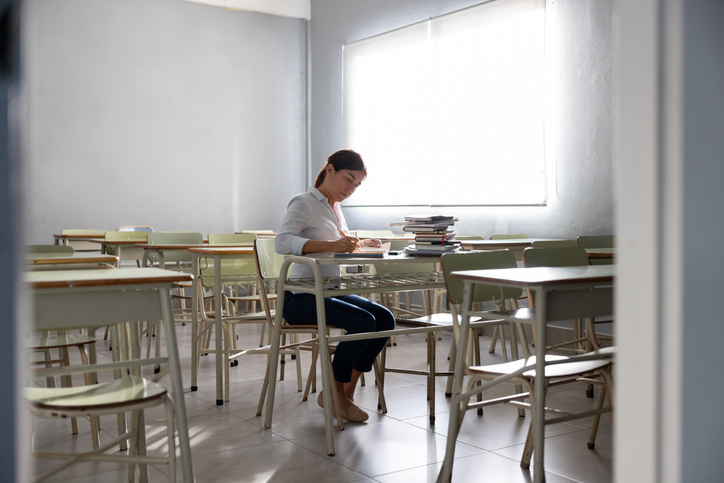Supporting teacher wellbeing at the start of term is integral to sustaining their wellbeing long-term, according to UNSW research. Understanding how we can better support teacher wellbeing and how it changes over time will help reduce the current high burnout and attrition rates, says Scientia Associate Professor Rebecca Collie from UNSW’s School of Education.
“Teacher well-being is of critical importance to healthy functioning at work and to students’ academic development,” says the world-leading educational psychology researcher. “Our research found teachers’ levels of wellbeing at these starting points, as well as the perceived quality of their connection with students are significant in shaping subsequent patterns of wellbeing.”
A study published in late 2023, conducted with Scientia Professor Andrew Martin from UNSW, examined how teacher wellbeing changes over one school term, and the role of teacher-student relationships in how these changes unfold. It followed 401 primary (56 per cent) secondary (38 per cent) kindergarten to year 12 (6 per cent) schoolteachers from all Australian states and territories, during Term 3 in 2021.
Teachers reported on their wellbeing and their sense of connection with students in weeks two, five and eight of the 10-week term. Teacher burnout is reported over the course of the term, the research found.
“Importantly though, teachers who reported more positive teacher-student relationships at the start of term ended the term with higher [rates of] wellbeing than those teachers who started the term with less positive teacher-student relationships,” she says.
“Our findings highlight the interconnectedness of teacher wellbeing and teacher-student relationships and underscore the importance of introducing efforts to bolster both.”
A/Prof. Collie conducts research into motivation, wellbeing and social-emotional development using quantitative research methods. She works with unions, government and researchers in Australia and internationally to promote evidence-led change in educational policy and practice. Her research is regularly cited in OECD education reports and referenced in Senate inquiries into education. It aims to identify how to support teachers and students to thrive socially, emotionally and academically.
What does research on teacher burnout say?

A/Prof. Collie states that teacher wellbeing comprises both feeling good and functioning effectively at work. Factors such as job satisfaction, a sense of vitality, and low stress or burnout at work capture the ‘feeling good’ aspect. Conversely, factors like work engagement and occupational commitment capture the ‘functioning effectively’ aspect of the definition.
In the study, researchers utilized the Tripartite Occupational Well-Being Scale, which A/Prof. Collie developed, to examine the emotional, cognitive, and behavioral elements of well-being. The scale identifies three types of wellbeing as key to teachers’ healthy and effective functioning: vitality – the energy and vibrancy that teachers feel in their work; engagement – the dedication and exertion that teachers channel into their job; and professional growth – teachers’ commitment to enhancing their expertise and competencies.
The research found all three types of well-being declined over the course of the term. “This applied to all different types of teachers [regardless of age, gender and experience], highlighting the need for ongoing efforts to support teacher wellbeing,” A/Prof. Collie says.
The research did, however, reveal some interesting minor variations. For example, female teachers started the term with lower vitality, but higher engagement than male teachers. More experienced teachers started the term with higher engagement than less experienced teachers. These insights will help guide further research to help us tailor responses to improve teacher wellbeing, she says.
Educators report some of the highest rates of psychological stress and teacher burnout. A national survey of more than 4000 teachers, conducted by the Black Dog Institute in 2023, found 70 per cent reported having unmanageable workloads. In the survey, 52 per cent reported moderate to extremely severe symptoms of depression and 59.7 per cent reported feeling stressed (compared to 12.1 per cent and 11.4 per cent of the general population respectively).
Additionally, Australian schools are facing unprecedented supply and teacher burnout challenges, only exacerbated by the pressures of the COVID pandemic. Modelling of teacher supply and demand has suggested shortages could worsen over the coming years, with the demand for secondary teachers to exceed the supply of new graduate teachers by around 4100 between 2021 to 2025.
“Historically, teaching has had a high rate of early-career attrition – teaching is a very rewarding profession, but it can also be challenging – however, this has now grown in all career-stage categories,” A/Prof. Collie says. “The issue is sector-wide – affecting both public and private schools – and is a recognised problem internationally.”
How schools can support teacher wellbeing?
A/Prof. Collie’s research into factors that support teacher well-being is contributing to policy development as well as assisting school leadership with practical evidence-driven strategies for improving teacher wellbeing.
She has examined the relationship between social supports at work (job ‘resources’) and common challenges for teachers (job ‘demands’) with teacher wellbeing and their intentions to seek alternative employment (turnover intentions). 426 Australian school teachers participated in the study.
“Time pressure, disruptive student behaviour and a lack of relevant professional learning opportunities are all common challenges for teachers,” she says.
“Conversely teachers who experience social supports, such as school leadership that encourages teacher agency and initiative at work – and positive relationships with both colleagues and students consistently demonstrated higher rates of wellbeing and lower intentions to leave teaching.”
Streamlining teachers’ work – reducing administrative tasks and face-to-face teaching time – is important, particularly at the start of term. Similarly, inviting teachers’ input in decisions and school policies and providing rationales for work tasks are some of the ways schools can support greater wellbeing, she says.
“Fostering collaborative relationships between staff also promotes higher wellbeing,” she says. “Providing common planning time, establishing professional learning communities and peer-mentorships, developing a shared mission and cultivating a supportive staffroom are relevant strategies for this.”
These can help teachers experience greater well-being and interpersonal relationships in the workplace – leading to more optimal outcomes for both teachers and students.
Schools can promote high-quality student-teacher interactions through ongoing support and feedback as well as teachers’ professional learning and goal setting around improving particular student-relationships, she says.
She suggests that schools can consider implementing strategies such as offering professional learning opportunities focused on high-quality teaching interactions, aligning content and teaching approaches with student interests, and providing resources and support for managing stress and workload.
“Feedback appeared even more crucial when teachers faced high levels of disruptive student behaviour,” she says. “The results were comparable across all four nations.”
The study used data from the OECD’s Teaching and Learning International Survey (TALIS).
These supports and challenges tap into the basic psychological needs related to autonomy, competence and connection essential for optimal human functioning, she says. “It’s a social imperative that we take care of workers in any field; low wellbeing negatively affects our interpersonal relationships and quality of life, increases the burden on medical services, and reduces economic productivity, among other reasons,” she says.
Moreover, improving teacher wellbeing has significant societal impact. “Teacher well-being is relevant for creating successful schools, and helping students’ long-term outcomes – academic, social, emotional, financial – as well as their wellbeing,” she says.
“Schools play a huge role in developing these. Promoting positive teacher wellbeing has huge benefits for our society and for our future generations.”
This blog was originially publised on UNSW Sydney Newsroom and is republished here with permission. Read the original here.
Improve school-wide student wellbeing
Better support student mental health through a peer-led approach to wellbeing, trusted by 620+ schools Australia-wide.





